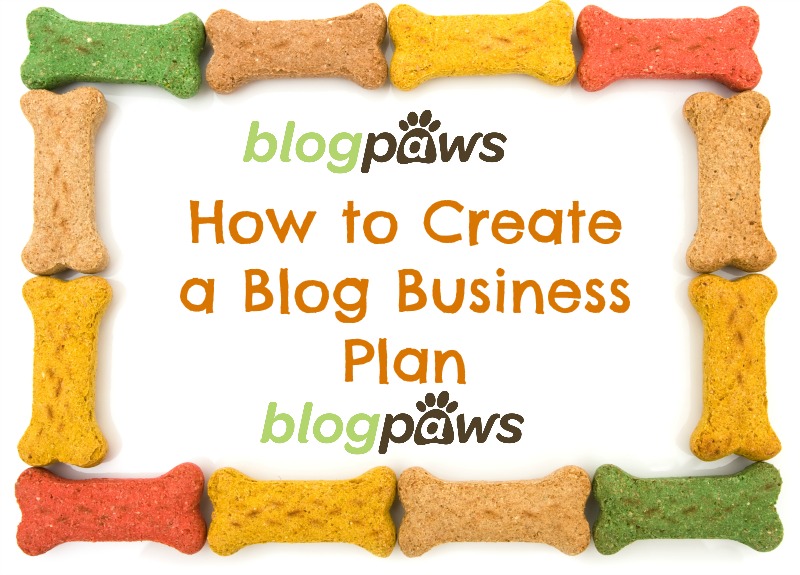How to Create a Blog Business Plan
by: Carol Bryant
I want to monetize my blog.
These are words I read or hear at least 5 to 10 times a week, possibly more. In order to make money you have to have a plan, right? Even if you are applying for a part-time job, having a game plan for how obtain that part-time job takes a plan. You peruse job listings, apply for the ones that interest you, follow up, have an interview, and ultimately you either get a call back or not. The way to monetize a blog is very similar. You need to have a plan, or in this case: A blog business plan.
If you attend any of the #BlogPawsChat sessions held on Twitter most Tuesdays from 8 to 10 pm est, you know we talk about the business of blogging. A plan is essential to take your blog from step A to step Z and all the nuances in between. Those nuances are what get my blog through its daily, weekly, monthly, and ultimately, yearly goals. Think of a blog business plan as a resume for your blog but with more detail, deadlines, goals, and direction.
Here is a basic template of things you should include in a blog business plan. And I happen to update mine yearly, since my goals change now and again. Don’t feel that you have to sit down and get this done in one hour or even one or two sittings. Allow yourself a period of time to get a blog business plan in place. This is something I recommend to bloggers at all levels. None of us is immune to good planning to take our dreams and turn them into monetization goals. Oh and even if monetizing is not on your agenda, a blog business plan is a good idea just to keep your blog on track and headed for success and growth.
Part One: Define Your Blog and Its Purpose
What is the mission of your blog for your readers (part A)
What is the purpose and mission of your blog as a business for YOU (part B)
Part A is your “elevator pitch” – the statement you can say about your blog if stuck on an elevator with someone and you had to explain it within in 30 seconds. So for my blog, Fidose of Reality, that is “Fidose of Reality is an alternative living magazine-style dog blog if your heart beats dog. We unite dog lovers of the highest order.”
Part B is more intensive and took me a few days to assemble this. Here, you clearly outline the business purpose of your blog. Why does your blog (as a business) exist? You don’t walk into a retail store and help yourself to merchandise without paying and the same holds true for monetizing a blog: I have eight or nine items on my blog as a business plan in this section.
Part Two: Define yourself and who you are.
How do you want the world to perceive your blog? What is your niche or microniche? Pet blog is a niche but pet-friendly travel is a microniche, for example. Are you a dog trainer who imparts her skills, advice, videos, and techniques on her blog? Are you a health-conscious dog mom or dog dad who incorporates physical fitness into blog advice? Be clear about who you are before you walk any further down the blogging road.
Part Three: Who is Your Demographic/Audience/Target Reader
If you write it, readers will come, right? Not always, so if you want the readers, then identify them and determine how you will find them (more about that in your social media strategy). Who are you writing for? What are your current demographics as indicated by Alexa or Google Analytics? Do you have a younger demographic and want an older one? Are you happy with the readers you have? Are you attracting mostly other bloggers in your niche? If that’s what you want, that’s fine, but define what you want and who you want.
Part Four: Finances and Budget
I could not believe what my costs were for maintaining a blog when I first sat down to do a business plan about two years ago. Prior to that, I was pretty much freestyling it, and I do not recommend this approach. All businesses have some type of fees involved, and blogging is no different. You invest in things like a computer, but so much more, including (well for me, this is a basic list):
- Backup program
- PicMonkey service
- Tech person to help on the back end – if needed
- Server fees
- Hosting fees
- Advertising costs (Facebook, etc)
- Contest fees
- Postage for contest and shipping to winners of prizes
- Graphics, templates
- Business cards
- Membership associations
- Fees to conferences like BlogPaws
- Trademarks, logos, artwork – if needed
- PayPal fees
And so on – this is just a sampling. When you see the fees, you might think twice when a brand comes knocking and finds it acceptable to offer you treats in return for a fantastic review because it would be good for your blog traffic to do so. I say okay now and then to freebies if I have a relationship established and it will benefit me and my blog. My business plan keeps me on track, especially this section. The person pitching you is getting paid to do so and you should get paid to do your job, too. Bloggers are influencers, so keep this in mind.
Part Five: Long-Term Goals
I have a long-term goal section for this year and for next year and the one after – you can choose to do them all at once or just a month at a time. However, I highly recommend you at least have a yearly goal. What do you want from your blog a year from now? Define it before you can pursue it. As I told a blogger this week, you can’t get in a car and expect to arrive at your destination without a clear sense of the route to get there. GPS helps in the car and a blog business plan helps keep you on course.
Part Six: Marketing Plan
Aside from the business plan, a subsection included is marketing plan. My marketing plan includes goals/strategies/tactics to market my blog. Marketing is a combination of product, price, promotion, and distribution (thank you business classes in college). So consider what you are selling, what price points you have set, and how you will promote your blog. For distribution, this applies more to a tangible product, but don’t skip that. The Marketing plan should include a completed media kit, pricing your services, working with advertisers, brands, networks, affiliates, etc.
Part Seven: Immediate and Short-Term Goals
Having a long-term goal in place was done earlier in the business plan because in this section you will develop bite-sizes achievable ways to get to that long-term goal(s). Take it month by month and set those goals for that month only. Do you want an editorial calendar? Do you want to write elsewhere to gain more traffic and name recognition? Do you want to get to BlogPaws in person? How much money do you need to save in order to get there? These things need to be built into your goals. In fact, build your finances into that section. Decide that you are coming to the BlogPaws Conference and then how to make it financially happen. Start saving NOW for the 2015 conference.
Do you have a business plan for your blog? Would you like to see a community-centered chat on this topic? In fact, one of the sessions at BlogPaws in May deals with your blog as a business and monetizing. An entire workshop is devoted to the topic, so hope to see you there.
Leave a comment below and let us know: Got a plan?









3 Comments